Tianhong Li
Unified Autoregressive Visual Generation and Understanding with Continuous Tokens
Mar 17, 2025Abstract:We present UniFluid, a unified autoregressive framework for joint visual generation and understanding leveraging continuous visual tokens. Our unified autoregressive architecture processes multimodal image and text inputs, generating discrete tokens for text and continuous tokens for image. We find though there is an inherent trade-off between the image generation and understanding task, a carefully tuned training recipe enables them to improve each other. By selecting an appropriate loss balance weight, the unified model achieves results comparable to or exceeding those of single-task baselines on both tasks. Furthermore, we demonstrate that employing stronger pre-trained LLMs and random-order generation during training is important to achieve high-fidelity image generation within this unified framework. Built upon the Gemma model series, UniFluid exhibits competitive performance across both image generation and understanding, demonstrating strong transferability to various downstream tasks, including image editing for generation, as well as visual captioning and question answering for understanding.
Fractal Generative Models
Feb 25, 2025Abstract:Modularization is a cornerstone of computer science, abstracting complex functions into atomic building blocks. In this paper, we introduce a new level of modularization by abstracting generative models into atomic generative modules. Analogous to fractals in mathematics, our method constructs a new type of generative model by recursively invoking atomic generative modules, resulting in self-similar fractal architectures that we call fractal generative models. As a running example, we instantiate our fractal framework using autoregressive models as the atomic generative modules and examine it on the challenging task of pixel-by-pixel image generation, demonstrating strong performance in both likelihood estimation and generation quality. We hope this work could open a new paradigm in generative modeling and provide a fertile ground for future research. Code is available at https://github.com/LTH14/fractalgen.
Fluid: Scaling Autoregressive Text-to-image Generative Models with Continuous Tokens
Oct 17, 2024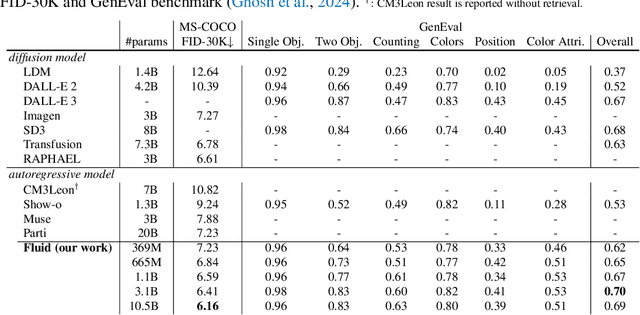

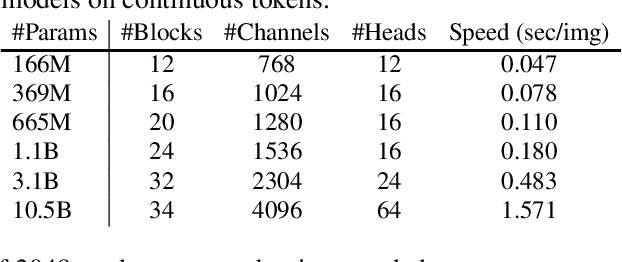
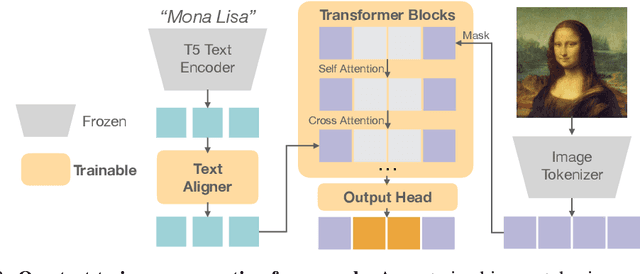
Abstract:Scaling up autoregressive models in vision has not proven as beneficial as in large language models. In this work, we investigate this scaling problem in the context of text-to-image generation, focusing on two critical factors: whether models use discrete or continuous tokens, and whether tokens are generated in a random or fixed raster order using BERT- or GPT-like transformer architectures. Our empirical results show that, while all models scale effectively in terms of validation loss, their evaluation performance -- measured by FID, GenEval score, and visual quality -- follows different trends. Models based on continuous tokens achieve significantly better visual quality than those using discrete tokens. Furthermore, the generation order and attention mechanisms significantly affect the GenEval score: random-order models achieve notably better GenEval scores compared to raster-order models. Inspired by these findings, we train Fluid, a random-order autoregressive model on continuous tokens. Fluid 10.5B model achieves a new state-of-the-art zero-shot FID of 6.16 on MS-COCO 30K, and 0.69 overall score on the GenEval benchmark. We hope our findings and results will encourage future efforts to further bridge the scaling gap between vision and language models.
Autoregressive Image Generation without Vector Quantization
Jun 17, 2024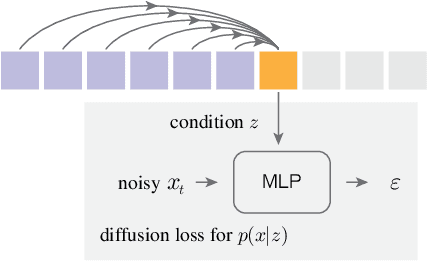

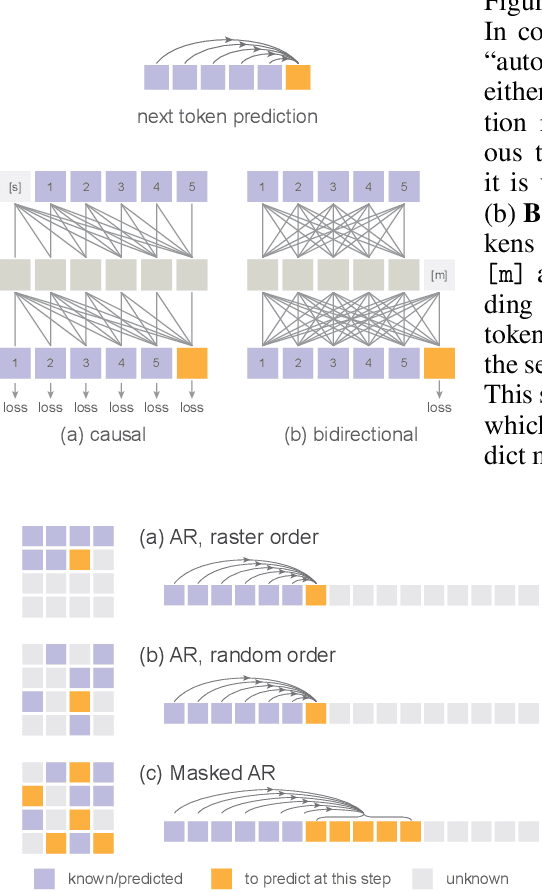

Abstract:Conventional wisdom holds that autoregressive models for image generation are typically accompanied by vector-quantized tokens. We observe that while a discrete-valued space can facilitate representing a categorical distribution, it is not a necessity for autoregressive modeling. In this work, we propose to model the per-token probability distribution using a diffusion procedure, which allows us to apply autoregressive models in a continuous-valued space. Rather than using categorical cross-entropy loss, we define a Diffusion Loss function to model the per-token probability. This approach eliminates the need for discrete-valued tokenizers. We evaluate its effectiveness across a wide range of cases, including standard autoregressive models and generalized masked autoregressive (MAR) variants. By removing vector quantization, our image generator achieves strong results while enjoying the speed advantage of sequence modeling. We hope this work will motivate the use of autoregressive generation in other continuous-valued domains and applications.
Self-conditioned Image Generation via Generating Representations
Dec 08, 2023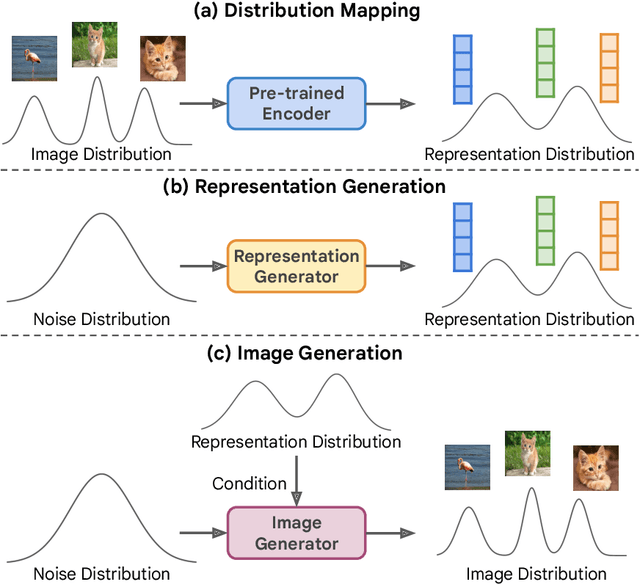
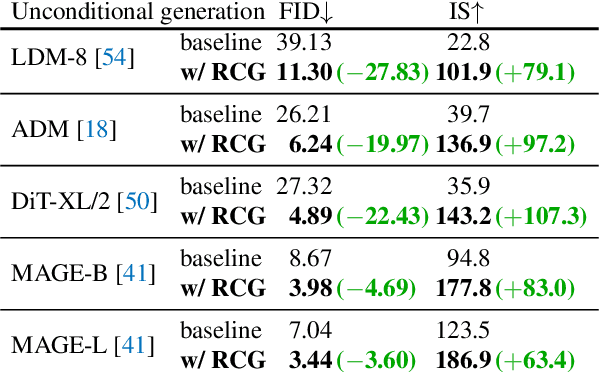
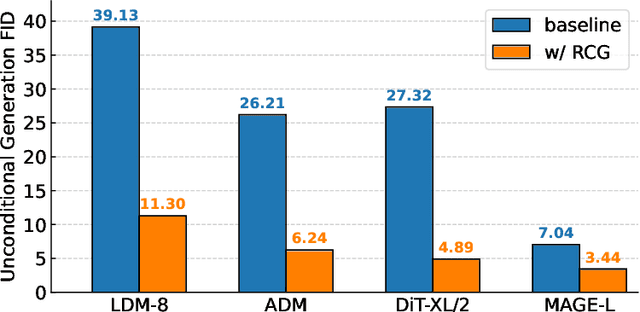
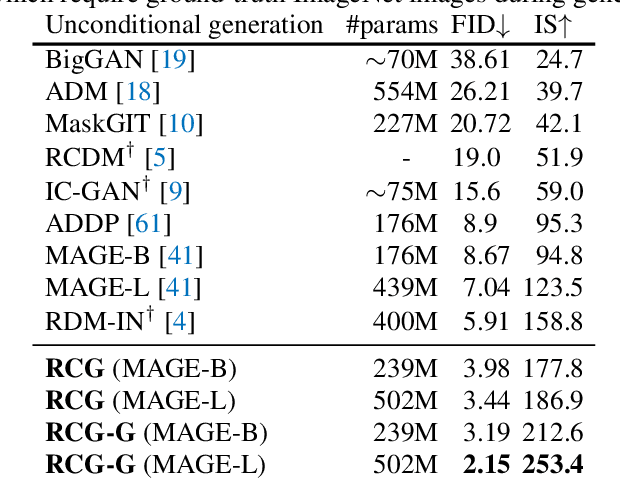
Abstract:This paper presents $\textbf{R}$epresentation-$\textbf{C}$onditioned image $\textbf{G}$eneration (RCG), a simple yet effective image generation framework which sets a new benchmark in class-unconditional image generation. RCG does not condition on any human annotations. Instead, it conditions on a self-supervised representation distribution which is mapped from the image distribution using a pre-trained encoder. During generation, RCG samples from such representation distribution using a representation diffusion model (RDM), and employs a pixel generator to craft image pixels conditioned on the sampled representation. Such a design provides substantial guidance during the generative process, resulting in high-quality image generation. Tested on ImageNet 256$\times$256, RCG achieves a Frechet Inception Distance (FID) of 3.31 and an Inception Score (IS) of 253.4. These results not only significantly improve the state-of-the-art of class-unconditional image generation but also rival the current leading methods in class-conditional image generation, bridging the long-standing performance gap between these two tasks. Code is available at https://github.com/LTH14/rcg.
Leveraging Unpaired Data for Vision-Language Generative Models via Cycle Consistency
Oct 05, 2023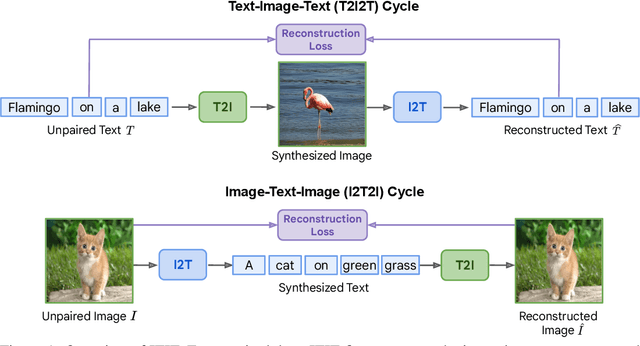
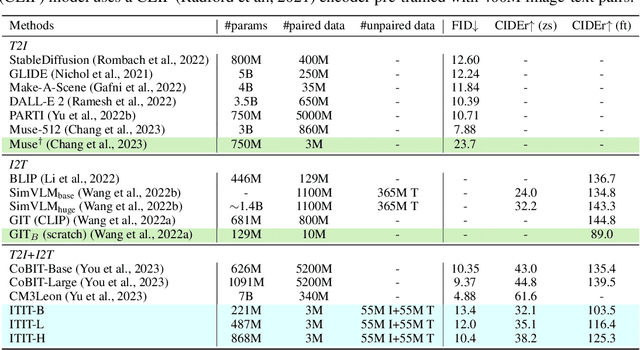
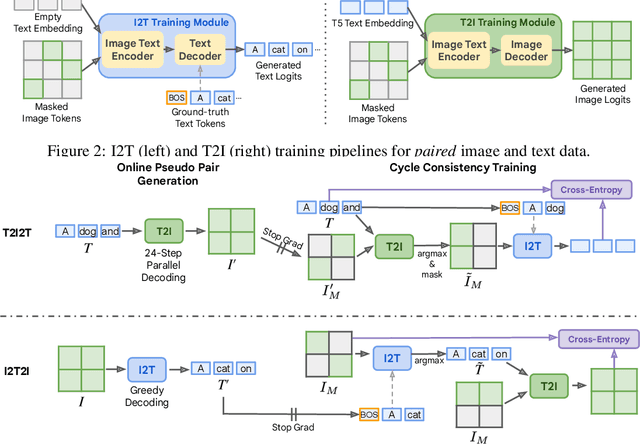
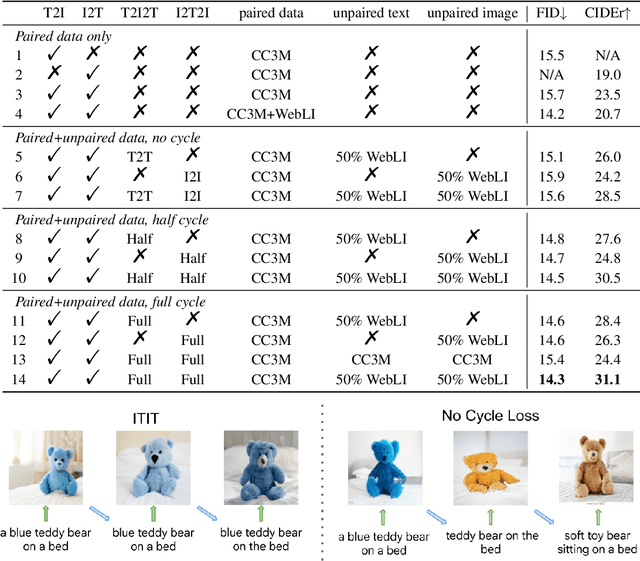
Abstract:Current vision-language generative models rely on expansive corpora of paired image-text data to attain optimal performance and generalization capabilities. However, automatically collecting such data (e.g. via large-scale web scraping) leads to low quality and poor image-text correlation, while human annotation is more accurate but requires significant manual effort and expense. We introduce $\textbf{ITIT}$ ($\textbf{I}$n$\textbf{T}$egrating $\textbf{I}$mage $\textbf{T}$ext): an innovative training paradigm grounded in the concept of cycle consistency which allows vision-language training on unpaired image and text data. ITIT is comprised of a joint image-text encoder with disjoint image and text decoders that enable bidirectional image-to-text and text-to-image generation in a single framework. During training, ITIT leverages a small set of paired image-text data to ensure its output matches the input reasonably well in both directions. Simultaneously, the model is also trained on much larger datasets containing only images or texts. This is achieved by enforcing cycle consistency between the original unpaired samples and the cycle-generated counterparts. For instance, it generates a caption for a given input image and then uses the caption to create an output image, and enforces similarity between the input and output images. Our experiments show that ITIT with unpaired datasets exhibits similar scaling behavior as using high-quality paired data. We demonstrate image generation and captioning performance on par with state-of-the-art text-to-image and image-to-text models with orders of magnitude fewer (only 3M) paired image-text data.
Reparo: Loss-Resilient Generative Codec for Video Conferencing
May 23, 2023



Abstract:Loss of packets in video conferencing often results in poor quality and video freezing. Attempting to retransmit the lost packets is usually not practical due to the requirement for real-time playback. Using Forward Error Correction (FEC) to recover the lost packets is challenging since it is difficult to determine the appropriate level of redundancy. In this paper, we propose a framework called Reparo for creating loss-resilient video conferencing using generative deep learning models. Our approach involves generating missing information when a frame or part of a frame is lost. This generation is conditioned on the data received so far, and the model's knowledge of how people look, dress, and interact in the visual world. Our experiments on publicly available video conferencing datasets show that Reparo outperforms state-of-the-art FEC-based video conferencing in terms of both video quality (measured by PSNR) and video freezes.
MAGE: MAsked Generative Encoder to Unify Representation Learning and Image Synthesis
Nov 16, 2022Abstract:Generative modeling and representation learning are two key tasks in computer vision. However, these models are typically trained independently, which ignores the potential for each task to help the other, and leads to training and model maintenance overheads. In this work, we propose MAsked Generative Encoder (MAGE), the first framework to unify SOTA image generation and self-supervised representation learning. Our key insight is that using variable masking ratios in masked image modeling pre-training can allow generative training (very high masking ratio) and representation learning (lower masking ratio) under the same training framework. Inspired by previous generative models, MAGE uses semantic tokens learned by a vector-quantized GAN at inputs and outputs, combining this with masking. We can further improve the representation by adding a contrastive loss to the encoder output. We extensively evaluate the generation and representation learning capabilities of MAGE. On ImageNet-1K, a single MAGE ViT-L model obtains 9.10 FID in the task of class-unconditional image generation and 78.9% top-1 accuracy for linear probing, achieving state-of-the-art performance in both image generation and representation learning. Code is available at https://github.com/LTH14/mage.
Unsupervised Learning for Human Sensing Using Radio Signals
Jul 06, 2022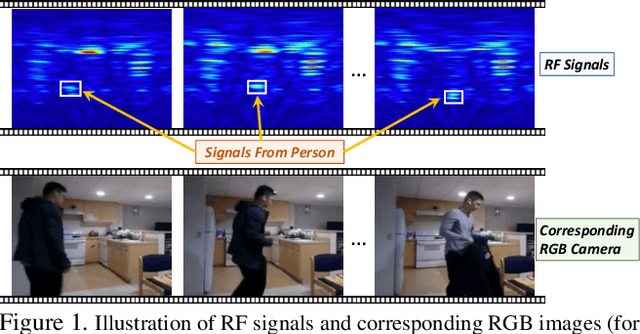
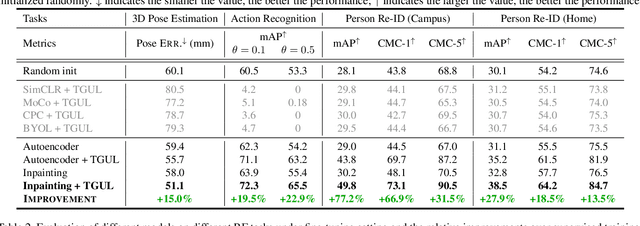
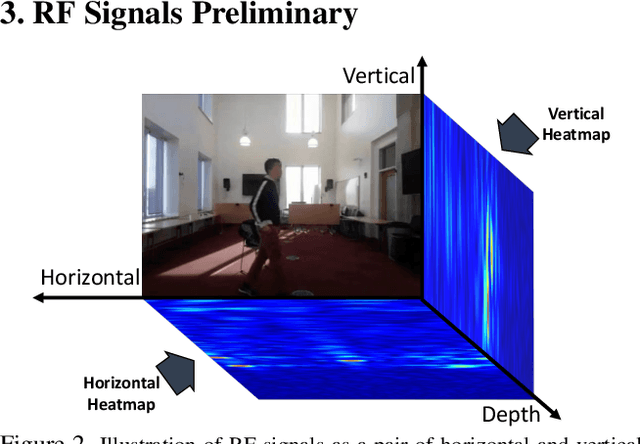
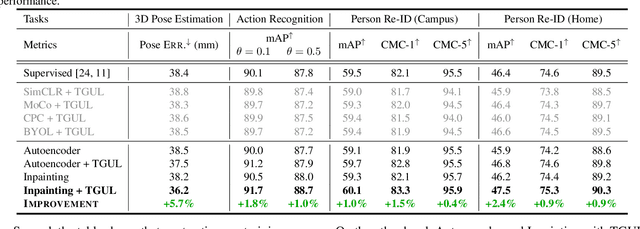
Abstract:There is a growing literature demonstrating the feasibility of using Radio Frequency (RF) signals to enable key computer vision tasks in the presence of occlusions and poor lighting. It leverages that RF signals traverse walls and occlusions to deliver through-wall pose estimation, action recognition, scene captioning, and human re-identification. However, unlike RGB datasets which can be labeled by human workers, labeling RF signals is a daunting task because such signals are not human interpretable. Yet, it is fairly easy to collect unlabelled RF signals. It would be highly beneficial to use such unlabeled RF data to learn useful representations in an unsupervised manner. Thus, in this paper, we explore the feasibility of adapting RGB-based unsupervised representation learning to RF signals. We show that while contrastive learning has emerged as the main technique for unsupervised representation learning from images and videos, such methods produce poor performance when applied to sensing humans using RF signals. In contrast, predictive unsupervised learning methods learn high-quality representations that can be used for multiple downstream RF-based sensing tasks. Our empirical results show that this approach outperforms state-of-the-art RF-based human sensing on various tasks, opening the possibility of unsupervised representation learning from this novel modality.
Targeted Supervised Contrastive Learning for Long-Tailed Recognition
Nov 27, 2021



Abstract:Real-world data often exhibits long tail distributions with heavy class imbalance, where the majority classes can dominate the training process and alter the decision boundaries of the minority classes. Recently, researchers have investigated the potential of supervised contrastive learning for long-tailed recognition, and demonstrated that it provides a strong performance gain. In this paper, we show that while supervised contrastive learning can help improve performance, past baselines suffer from poor uniformity brought in by imbalanced data distribution. This poor uniformity manifests in samples from the minority class having poor separability in the feature space. To address this problem, we propose targeted supervised contrastive learning (TSC), which improves the uniformity of the feature distribution on the hypersphere. TSC first generates a set of targets uniformly distributed on a hypersphere. It then makes the features of different classes converge to these distinct and uniformly distributed targets during training. This forces all classes, including minority classes, to maintain a uniform distribution in the feature space, improves class boundaries, and provides better generalization even in the presence of long-tail data. Experiments on multiple datasets show that TSC achieves state-of-the-art performance on long-tailed recognition tasks.
 Add to Chrome
Add to Chrome Add to Firefox
Add to Firefox Add to Edge
Add to Edge